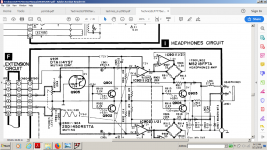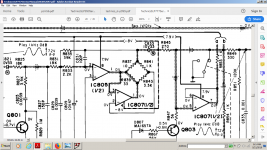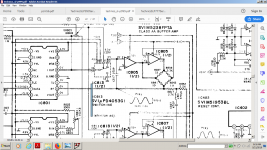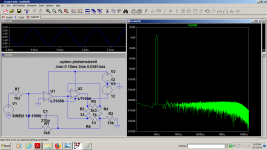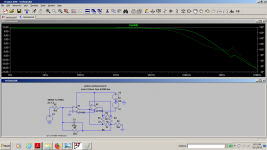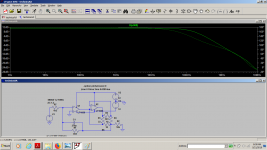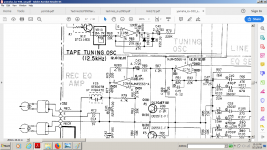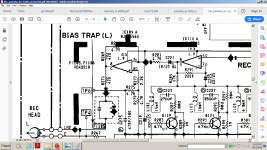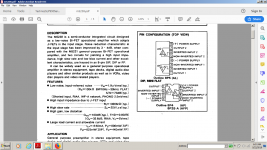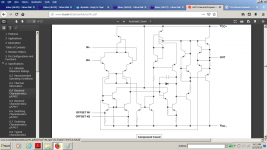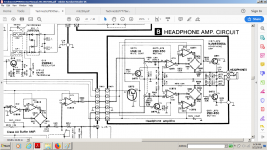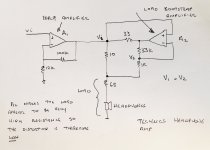Looking at ways to improve my new NEC player i ran into these Technics schematics i was never aware of.Could you tell me more about these composite op-amps circuits? I don't have a clear understanding of what they do right now.
Attachments
Last edited:
That's what ears areWho needs ears when you have a spectrum analyzer!
Jan
Indeed, Scott, the second op-amp is just unity gain.The only other similar circuit that i saw were in top end Yamaha cassette players in rec stage .
Sorry I removed my post while I tried to compute the exact magnitude of the effect, but yes it looks like they just want the second op-amp to take most of the load, not really a composite op-amp. It should be easy to sim.
Sorry I removed my post while I tried to compute the exact magnitude of the effect, but yes it looks like they just want the second op-amp to take most of the load, not really a composite op-amp. It should be easy to sim.
What I use for driving large cap loads. A 797 followed by a unity gain ol buffer BUF634, with overall feedback. Would you call that a comp opamp?
Jan
why not?
I wonder why this double feedback technique is used just is some circuits...I mean...what is the difference between a classical strapped unity gain with just a wire out-inv and a topology like this where you use both positive and negative feedback .
In Yamaha i could see an exact gain of 0.8x by this technique...
To be honest if i wouldn't be able to use spice i couldn't make the calculations.I simply don't know how to do it.
I wonder why this double feedback technique is used just is some circuits...I mean...what is the difference between a classical strapped unity gain with just a wire out-inv and a topology like this where you use both positive and negative feedback .
In Yamaha i could see an exact gain of 0.8x by this technique...
To be honest if i wouldn't be able to use spice i couldn't make the calculations.I simply don't know how to do it.
Attachments
Last edited:
Certainly wrapping a unity buffer into a control amp's feedback bloop is a form of composite (let's not try to get too hung up on semantics), but misses out on pushing more loop gain into the outer loop as well, so the control opamp is having to work a lot harder, albeit not its output stage.
Depending on the application, that may have negligible difference in result, an ad797 with a buf634 behind it is not going to be lacking within the buffer's operating range!
Depending on the application, that may have negligible difference in result, an ad797 with a buf634 behind it is not going to be lacking within the buffer's operating range!
Actually one reason I did it this way is that it is much easier (as in 'no oscillations') to drive a large cap load and still maintain low distortion. The open loop buffer is pretty insensitive to phase shift in the load current and nicely shields the main opamp fom it.
My app was a filter circuit.
There may be better ways, but this is all I know ;-)
Jan
My app was a filter circuit.
There may be better ways, but this is all I know ;-)
Jan
Looking at ways to improve my new NEC player i ran into these Technics schematics i was never aware of.Could you tell me more about these composite op-amps circuits? I don't have a clear understanding of what they do right now.
There's an app note somewhere (TI - Ray Mancinni - or was it or BB?) that shows a similar technique - kind of like 'load bootstrapping' so the second opamp takes the load while the first sees almost none and the result is very low distortion.
Looks quite neat.
I have used 'AFEC'.
Perhaps not as spectacular as Syn08's RF AF amplifier or the brute force composite approach, but it gets me below the QA401 noise floor.
Augmented Feedback Error Correction (AFEC)
Perhaps not as spectacular as Syn08's RF AF amplifier or the brute force composite approach, but it gets me below the QA401 noise floor.
Augmented Feedback Error Correction (AFEC)
They already use two of the best op-amps ever made ...i can hardly believe you'd need a more advanced topology for lm4562 or lt1056 than the datasheet provide to get a good sound.I have used 'AFEC'.
Perhaps not as spectacular as Syn08's RF AF amplifier or the brute force composite approach, but it gets me below the QA401 noise floor.
Augmented Feedback Error Correction (AFEC)
If you can get 85..90 db THD and IMD in all electronic audio chain that is all you need from a technical point of view..From that point on you better look for better speakers...
There may be better ways, but this is all I know ;-)
Jan
And when we get to the end of the day, you got it done, which is infinitely more important than the sixth or seventh zero.
... these composite op-amps circuits?...
The technicsslp777headphonesamp-png parallels two 50mA opamps to make a 100mA opamp to drive headphones. The booster runs at small gain. Why? Only the designer knows. These are not super-spiffy opamps (big-die '741s) and maybe by using two 15-cent opamps he got the performance of a 50-cent opamp.
On the contrary and this is what i emphasized a few pages back, which is that the composite op-amps are actually needed to be part of what the Burr Brown app note already said: the "BEST of BOTH WORLDS" for best results, otherwise you can find singular op-amps that can do the job :The technicsslp777headphonesamp-png parallels two 50mA opamps to make a 100mA opamp to drive headphones. The booster runs at small gain. Why? Only the designer knows. These are not super-spiffy opamps (big-die '741s) and maybe by using two 15-cent op-amps he got the performance of a 50-cent opamp.
You deliberately chose slp777 out of slp990 and slp999 maybe, where they use njm4556s and m5238 for all the positions.NJM4556S isn't the same thing with njm4556D as it has one more ground pin which internally forms also a cooler for the die.So yes, there were op-amps with ground too in the 80's!
M5238 wasn't cheap, still isn't cheap as second hand and still is one of the best op-amp made for audio.He was used in top-end commercial units ad still is great value along with its bipolar brother in arms M5220 which wasn't cheaper than m5219, which again wasn't cheaper than m5218...I think that some Japanese chips set the bar very high for real world performance at the time.
You have also the 741 internal guts...
You know...Japanese datasheet were very scarce compared with their American counterpart but they made wonderful parts which in real life are really difficult to beat in terms of overall performance unless you want to spend a lot of money to prove otherwise.
By the way, i just asked a friend who happened to have a Technics 990 and he said that although he has about 20 top-end cd players of that era (phillips cd880, cd304(i gave him one) and many others,all moded both on the digital and analog side-he has a PHD in numerical processing and he's also a church organ player so he's my refference when i want an opinion, the Technics happens to sound the most accurate.He never had Denons though
I will build that i/v stage of Technics and mod my NEC today just to see if it really makes a difference.I believe it does.
Attachments
Last edited:
Here's the Technics headphone amp.
A2 is the load bootstrap amplifier and makes the headphone load (that's the 68 ohm and the actual headphone impedance) appear very high to A1, the main amplifier. With A1 seeing little or no load, the distortion is concomitantly low.
You could do this with 2 off dual LM4562 - 1 acting as A1 and the other three you parallel and form A2 for theoretical ppb distortion levels. IIRC the LM4562 can cleanly deliver c. 30mA so you will have close to 100mA to drive your headphones.
Its a pretty neat trick in my book!
A2 is the load bootstrap amplifier and makes the headphone load (that's the 68 ohm and the actual headphone impedance) appear very high to A1, the main amplifier. With A1 seeing little or no load, the distortion is concomitantly low.
You could do this with 2 off dual LM4562 - 1 acting as A1 and the other three you parallel and form A2 for theoretical ppb distortion levels. IIRC the LM4562 can cleanly deliver c. 30mA so you will have close to 100mA to drive your headphones.
Its a pretty neat trick in my book!
Attachments
You could do this with 2 off dual LM4562 - 1 acting as A1 and the other three you parallel and form A2 for theoretical ppb distortion levels.
Its a pretty neat trick in my book!
You still have the unloaded THD of the first amp as a gain of ~10 follower (with 12k unbalanced source). I don't see -170dB out of this.
I agree that the -170dB THD is pie in the sky - LTspice fantasy.
If you ran A1 with a heavy load, the distortion would go up significantly, so I would say what this does is deliver the distortion performance of A1 when driving a high load so for a good opamp 1-2ppm. The ppb I mentioned is 'theoretical' of course.
You could tweak this design for improved performance - e.g. lower gain setting resistors (4562/797 easily drive 1k at ppm levels) and maybe run A1 inverting to remove CM distortion etc etc
If you ran A1 with a heavy load, the distortion would go up significantly, so I would say what this does is deliver the distortion performance of A1 when driving a high load so for a good opamp 1-2ppm. The ppb I mentioned is 'theoretical' of course.
You could tweak this design for improved performance - e.g. lower gain setting resistors (4562/797 easily drive 1k at ppm levels) and maybe run A1 inverting to remove CM distortion etc etc
Last edited:
- Home
- Source & Line
- Analog Line Level
- Samuel Groner's super opamp
